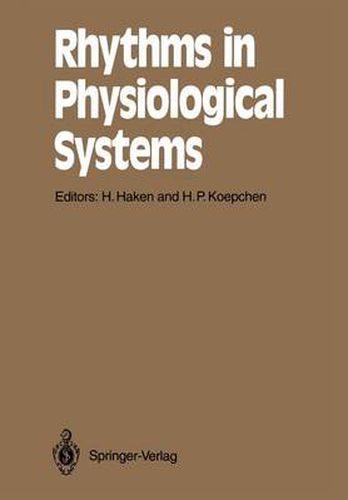Readings Newsletter
Become a Readings Member to make your shopping experience even easier.
Sign in or sign up for free!
You’re not far away from qualifying for FREE standard shipping within Australia
You’ve qualified for FREE standard shipping within Australia
The cart is loading…






This title is printed to order. This book may have been self-published. If so, we cannot guarantee the quality of the content. In the main most books will have gone through the editing process however some may not. We therefore suggest that you be aware of this before ordering this book. If in doubt check either the author or publisher’s details as we are unable to accept any returns unless they are faulty. Please contact us if you have any questions.
Rhythms are a basic phenomenon in all physiological systems. They cover an enormous range of frequencies with periods from the order of milliseconds up to some years. They are described by many disciplines and are investigated usually in the context of the physiology of the respective function or organ. The importance given to the research on rhythmicity is quite different in different systems. In some cases where the functional significance is obvious rhythms are at the center of interest, as in the case of respiration or locomotion. In other fields they are considered more or less as interesting epiphenomena or at best as indicators without essential functional significance, as in the case of cardiovascular or EEG rhythms. Recently the study of physiological rhythms has attracted growing interest in several fields, especially with respect to rhythm research in humans and its rapidly spreading applications in basic behavioral research, and as a diagnostic tool in clinical medicine. This development was favored by two methodological and conceptual ad vances: on the one hand, the availability of non-invasive methods of continu ous recording of physiological parameters and their computer-assisted evaluation, and on the other, the rapid development of theoretical analyses, for example, the understanding of dynamic systems, the generation of coordinated macroscopic pro cesses in systems comprising many single elements, and the mathematical tools for treating nonlinear oscillators and their mutual coupling.
$9.00 standard shipping within Australia
FREE standard shipping within Australia for orders over $100.00
Express & International shipping calculated at checkout
This title is printed to order. This book may have been self-published. If so, we cannot guarantee the quality of the content. In the main most books will have gone through the editing process however some may not. We therefore suggest that you be aware of this before ordering this book. If in doubt check either the author or publisher’s details as we are unable to accept any returns unless they are faulty. Please contact us if you have any questions.
Rhythms are a basic phenomenon in all physiological systems. They cover an enormous range of frequencies with periods from the order of milliseconds up to some years. They are described by many disciplines and are investigated usually in the context of the physiology of the respective function or organ. The importance given to the research on rhythmicity is quite different in different systems. In some cases where the functional significance is obvious rhythms are at the center of interest, as in the case of respiration or locomotion. In other fields they are considered more or less as interesting epiphenomena or at best as indicators without essential functional significance, as in the case of cardiovascular or EEG rhythms. Recently the study of physiological rhythms has attracted growing interest in several fields, especially with respect to rhythm research in humans and its rapidly spreading applications in basic behavioral research, and as a diagnostic tool in clinical medicine. This development was favored by two methodological and conceptual ad vances: on the one hand, the availability of non-invasive methods of continu ous recording of physiological parameters and their computer-assisted evaluation, and on the other, the rapid development of theoretical analyses, for example, the understanding of dynamic systems, the generation of coordinated macroscopic pro cesses in systems comprising many single elements, and the mathematical tools for treating nonlinear oscillators and their mutual coupling.